Regular progress reports start right now! I hope to have a new one each week or so.
Today’s Music Choice
“Eden’s Last Sunrise (Main Theme)”. It plays during the introduction and character creation bit, so it’s appropriate for today.
Character Introduction: The Commander of the Cradle Project
The first character introduction is all about you! The hero. The avatar. The chosen one. The lone wanderer. The blank slate. The not-exactly-silent protagonist. The commander of the Cradle Project.
At the start of the game, you’ll get the opportunity to create a character to represent yourself in the game world. Your character will have their own dialog, make major decisions, and actively participate in story beats. You get a pretty thorough amount of customization, in both appearance and behavior. Your commander will also participate in most battles (either required, or optionally), and will grow and level up just like any other character or recruit.
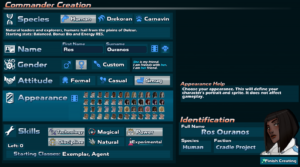 Let’s take a look at the customization options! Note that most of these will apply to custom party members as well.
Let’s take a look at the customization options! Note that most of these will apply to custom party members as well.
First, you get to choose your species: either human, drekoran, or carnavin. This changes your appearance options, obviously, and also affects a few starting stats, to give a little variation amongst new characters. There will also be small dialog changes based on your species, but nothing that would affect content in a major way.
Next, you can set a first name and surname. You’ll mostly see your first name in regular gameplay, though more formal characters may refer to you with your surname instead. You get a few options here.
- The default is “Ros Ouranos,” which is my go-to unisex default name from I Miss the Sunrise. No relation intended.
- You can also click the dice and generate a random, species-appropriate name. Each culture has its own naming conventions, so if you’re a stickler for lore and want to fit in with the other characters in the story, this is one way to go.
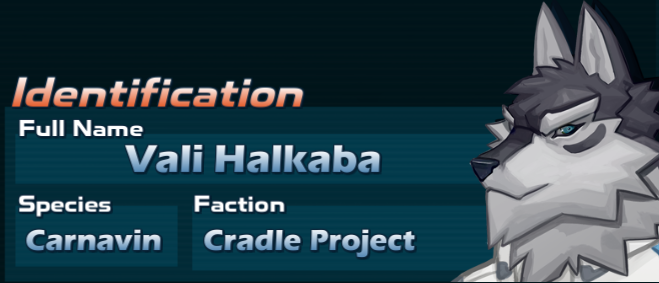
- Or, you can click the monkey and generate a “silly” name instead.
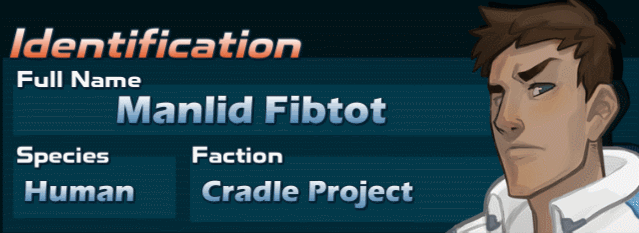
- Or, if you’re feeling creative, you can enter just about anything you want.
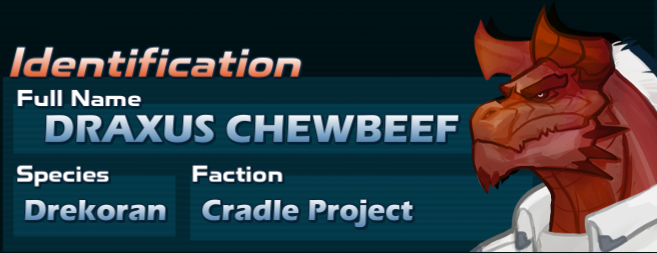
Next, gender and attitude are just for personal preference and don’t affect the gameplay or story. You can choose how others will address your character, and how your character’s dialog will be spoken. Yes, that means writing three distinct speaking styles for every bit of player dialog in the game. I’m ready. (Note that my original plan was a granular personality system that would change your dialog like in I Miss the Sunrise. However, I’ve scrapped that for the sake of making things easier on the player (and myself!), so while choosing your words carefully will still help you build trust with your allies faster, it’s no longer possible to completely lock yourself out of being someone’s pal because your personalities don’t align.) These are unique to your commander character, and don’t apply to custom characters.
Where were we? Oh, right. You can choose your appearance, next. This just affects your portrait and sprite, and is tied to your species. The commander has their own default outfit, but you will change to a class-specific outfit when you change classes. You can also choose to keep your “civilian” outfit instead. This goes for every character.
Finally, you can tag some skills! There are six “skills” that serve as a secondary sort of experience and leveling system for each character. During regular gameplay, these increase in a couple of ways. One way is participating in dispatch missions. For instance, if a mission calls for heavy lifting, you’ll want to send characters with decent Power skills to be successful. This mission might, in turn, increase their Discipline skill if they’re successful.
The second way is completing battles, of course. Basically, there is a “pool” of skill values that is created based on the characters you deploy. More specifically, it’s based on their classes. So, if you deploy a lot of magical-oriented classes into a battle, then your characters’ Magical skill will increase more greatly than their other skills once the battle is complete. So, it’s ideal to have a mix of classes so everyone’s skills rise evenly. Higher skill levels mean better success rates in dispatch missions, and they also affect the classes your character can switch to.
A new class is unlocked when a character’s skills reach the minimum required levels. For instance, the Agent class becomes available at Technology level 1, Power level 1, and Discipline level 1. Once a class is unlocked on one character, it’s visible to every character, but they cannot switch to it until they meet the minimum skill requirements. All characters start out with the “neophyte” class, which is essentially a “squire” – basic stats and abilities, and no real specialization, but wide equipment options. The commander has a special version of this called the “exemplar,” which has better stats and stronger versions of those basic abilities.
Anyway, you can tag three skills to start at level 2 for your commander’s character. Other skills will start at level 0. By tagging certain combinations, you can unlock a few of the basic classes from the start, like Agent or Medic. So, if you have your sights set on a certain role for your commander to take, you can give them a leg-up from the beginning. Or, if you imagine a certain history for them and wish to set their skills to reflect that, you can do that too.
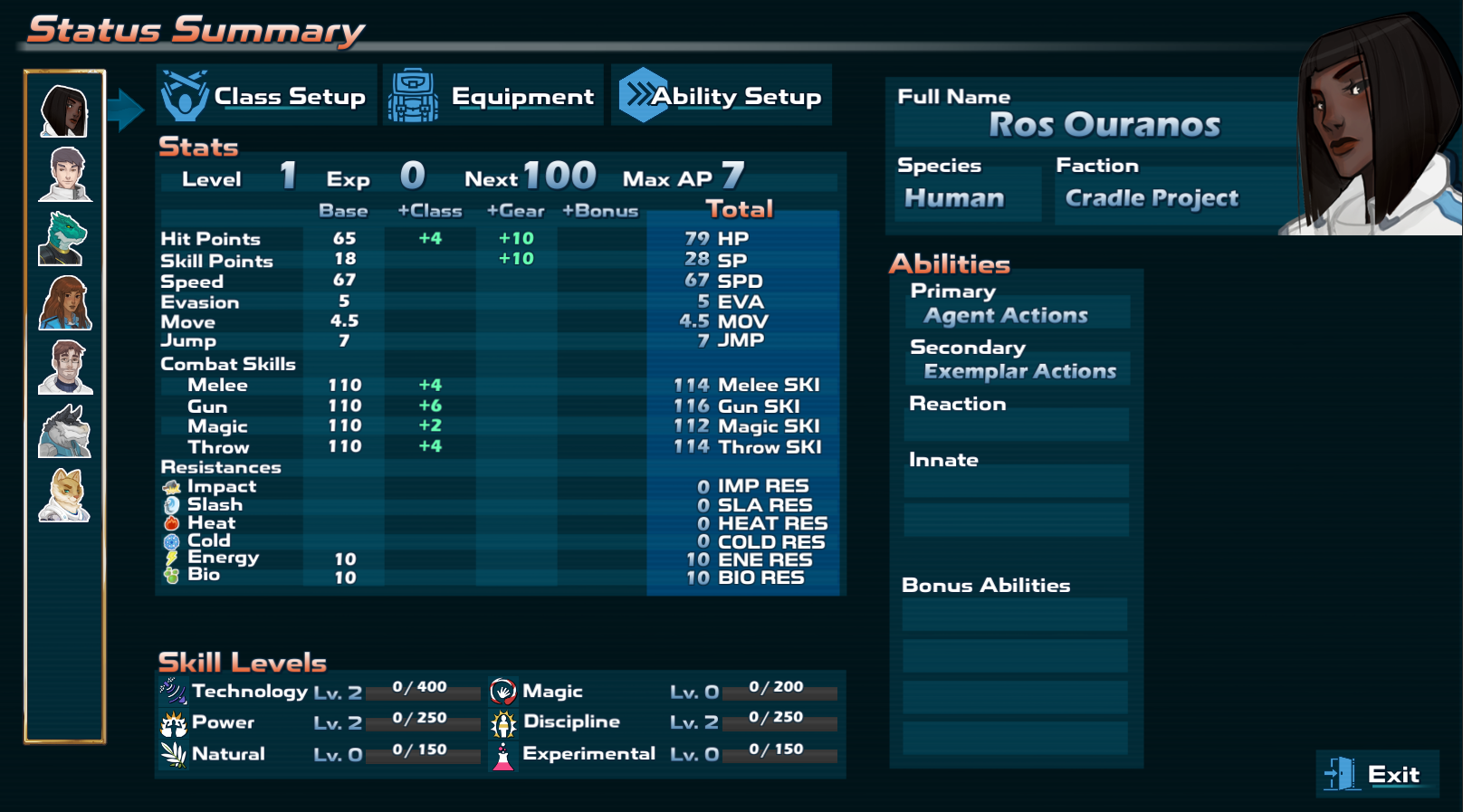
But, as you can see, that’s all working now! This is just a general character stat screen, so you can see what is affecting your allies’ stats. I’ve finished implementing all of the progression bits and pieces, like setting and unlocking classes, assigning actions, changing equipment, and learning new abilities. It’s almost starting to feel like an actual game!
Progress Report
I’ll admit I’ve gotten a bit sidetracked this week. Last week, I managed to finish the “deployment” system to let you pick and choose party members and dump them into the battlefield, and I finished that up a couple of days ahead of schedule. With some time to spare before my next self-prescribed milestone, I thought about how the interface should work on a gamepad or keyboard. Everything up to this point had been developed with the mouse in mind, and I started drawing out a huge, obnoxious spider web of how the interface elements should relate and navigate when you’re tabbing between them on a controller.
It was looking uglier and uglier, and then I had a realization: if everything is mouse-driven, then I should probably go with a virtual mouse cursor (driven by either the mouse or the gamepad) instead of trying to juggle two layers of navigation logic on top of one another – not to mention what to do if the player suddenly switches from a gamepad to a mouse, or back. But, with a virtual cursor, I can treat the interactions the same way no matter what. All I needed then was a brisk refresher on the engine’s event systems and graphics raycaster!
So, I got sidetracked by that for the past 4 days, as my implementation had the tendency to crash unexpectedly when the cursor passed over certain objects. I think I’ve got that almost completely sorted, though, so it should be up and working soon. Then, I need to implement the same thing onto the battle interface, which I did already write with two layers of navigation logic in mind. I think that getting away from trying to control an isometric grid-based cursor using a directional pad is, overall, a good thing for the player.
But once I’m done with that, I’m going to work on something more fun, which I’ll reveal next week. A fun little side-game within the main game, you might say. Stay tuned.
Next time: Character introduction #2: the Dwellers!





